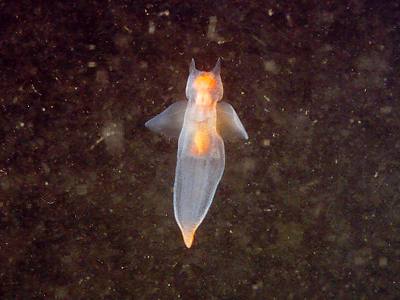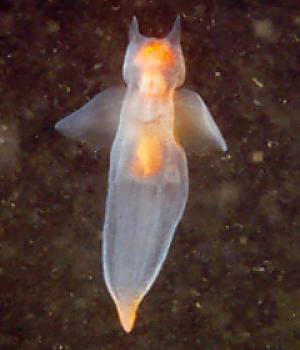Clione limacina from Quebec, Canada
June 25, 2003
From: Chantal Croteau

Dear Dr. Bill Rudman,
How amazed I was to find your web site! And to discover our little sea butterfly is widespread from Antarctica to Japan!!! (sorry for my English ... but I am very pleased to have the chance to share with you my story)
I am a diver who loves to visit the cold water of the province of Quebec, Canada. I was lucky to see my first Clione limacina at the Escoumins, in the St. Lawrence River (with the Labrador Stream and not the Gulf Stream - yes... cold sea water).
Somes identification guides revealed that whales includes this little pteropod in their food list (is it possible?). Clione limacina is wonderful and very gracious to see in the wild. I was very honored to look at this little pteropod in action, to swim in the cold water ... like flying in the sky! It is amazing!!! I was surprised to read that some people have tried to keep Clione in captivity? They can??? Or instead, they are able to keep them alive? wow...
Here, a picture taken at Escoumins, Canada, by Guy Lafond (my husband) in June 1996.
Thank you very much!
Chantal Croteau
cold water diver
guy.lafond@videotron.ca
Croteau, C., 2003 (Jun 25) Clione limacina from Quebec, Canada. [Message in] Sea Slug Forum. Australian Museum, Sydney. Available from http://www.seaslugforum.net/find/10308
Note added 20 June 2007: Carol Lalli has informed me that the excellent book Lalli & Gilmer (1989) is still available from Stanford University Press.
Dear Chantal,
Thanks for your message and the photo. Pteropods are indeed fascinating animals. If you an get hold of a copy of Lalli & Gilmer's book, which I think is unfortunately out of print, it has lots of information on the biology of the pteropods. Concerning where they live, in an earlier message I mentioned that we now think that the southern hemisphere populations are probably a separate species, but Clione limacina is still considered to be found all around the polar regions and northern temperate waters. Like you, it likes the cooler waters. Some whales certainly eat pteropods, but I don't think they pick and choose particular species. Baleen whales, such as the right whale, blue whale, and humpback, are plankton feeders, straining great quantities of microscopic animals with every mouthful of water.
Thanks again for sharing with us your photo and observations
• Lalli, C.M. & Gilmer, R.W. (1989) Pelagic Snails. The biology of holoplanktonic gastropod molluscs. Stanford University Press: Stanford, California.
Best wishes,
Bill Rudman
Related messages
-
Re: Clione limacina in Greenland
From: Andy Murray, November 26, 2007 -
Re: Clione limacina in Greenland
From: Andy Murray, November 12, 2007 -
Pteropods from New Jersey, USA
From: Kate Winters, October 3, 2007 -
Clione limacina in Greenland
From: Andy Murray, September 14, 2007 -
Re: Clione limacina from Newfoundland, Canada
From: Rob Freyer, June 27, 2007 -
Clione limacina from Newfoundland, Canada
From: Ryan Murphy, June 21, 2007 -
Does Clione limacina have eyes?
From: Sim Kah Chine, December 12, 2006 -
Clione limacina - how to keep alive?
From: Julie Lim, April 14, 2005 -
Bipolar distribution of Clione and Limacina
From: Yasuhiko Ito, May 2, 2003 -
What should we feed Clione?
From: S. Kumagai, March 28, 2003 -
Clione do exist!
From: Paul Dymond, March 2, 2003 -
Re: Where do I find Clione limacina?
From: Marli Wakeling, May 19, 2001 -
Where do I find Clione limacina?
From: Josh Rosenthal, May 15, 2001
